
Acrylics are mostly known for their ability to dry quickly, allowing artists to layer and over paint in rapid succession. Some artists even love to use fans or hairdryers to speed it along; however, there are many times when an effect is desired for which, frankly, acrylics dry too fast. This article hopes to explain both: how to control the drying rate of acrylics by discussing additives, studio conditions, and substrate; as well as describing the mechanisms of initial drying and how prolonged paint cure times may affect the properties of a dry paint film.
One area of initial control available to the artist is the layer immediately below where they will be painting. Substrates and absorbent layers (even previously painted layers with more porous pigment such as earth colors) tend to wick water away from the paint much faster than glossy/sealed layers. This causes paint, especially if in thin layers, to cure much faster as volatile components escape into the substrate as well as the atmosphere.
This image of Titan Buff next to Transparent Red Iron Oxide (right)is drawn out at a thickness of 3 mil (.003.) and shows very clearly how the substrate affects dry time. The first zone of uncoated hot pressed watercolor paper wicks away moisture so fast that the artist realistically has 1 minute of working time and everything is pretty locked down after 3 minutes. Next, we created a second zone by simply coating the paper with a layer of GOLDEN White Gesso. Even though Gesso is designed to be absorbent, it is dramatically more sealed than the paper and offers just less than 5 minutes of working time and is very locked down after 10 minutes. Finally, we coated the Gesso with an additional layer of gloss acrylic. In this case we used GAC 100, but any gloss gel or medium will work similarly. As you can see, having a sealed surface offers an impressive 15 to 20 minutes of active working time at 70F 50% Relative Humidity!
Often times, simply sealing sub-layers of a painting will provide greater blending time. Yet the look of a sealed layer may not be acceptable for ones style or it simply does not supply enough open time to complete a concept. If either of these conditions apply, it may be necessary to control the climate in which the painting is being created. Studio climate has a very dramatic effect on the curing rates of acrylic. By making small adjustments in temperature and humidity, surprising results can occur.
I once worked in a studio that was also a greenhouse in North Carolina in the summer months. It was a lovely space and I was very happy to have access to it at that time in order to work on larger paintings. However, as one could imagine, it was steamy in there with relative humidity probably near 100%. During the day the temperature was simply unbearable, so I would sleep odd hours and begin my studio practice around midnight. One early morning I wanted to paint a very soft gradient over the surface of a 4′ x 6′ gessoed canvas. Fearing that it would dry too fast, I first painted a layer of Acrylic Glazing Liquid (Gloss) over the surface and then began working into it with GOLDEN Heavy Body Acrylic colors. I painted comfortably for an hour or so before I had to run off for an appointment. Upset, I ventured out of the studio and nervously satisfied my obligation; the entire time visualizing this huge background locked down and unsalvageable. After about two hours I returned to the sauna-like studio, to find to my surprise, that the paint was still perfectly wet. I finished the background and then continued to check the painting for drying for the next three days! Wanting to continue with my next layers, I lugged the wet painting into a low humidity environment and, due to air conditioning which kept the room low in humidity, it cured touch dry in just a few minutes. This demonstrates very clearly the effect of environmental factors on curing. Fortunately, working in a greenhouse is not the only way to have a high humidity environment.
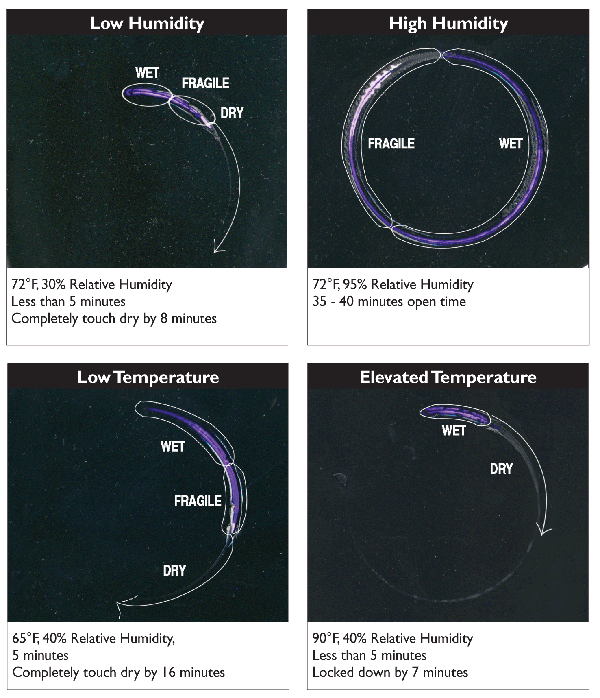
Above are images of Heavy Body Dioxazine Purple tested at a thickness of 10 mil for drying time in various climate conditions generated using the GOLDEN Laboratory environmental chamber and a 1 hour circle dry time recorder. In the first series we have maintained a comfortable room temperature and ramped up the humidity level. This simple test demonstrates the dramatic effect of humidity on cure time.
You can see from the results that humidity has a much greater effect on drying time than does temperature. So why does humidity affect the drying rate of water-based paints? This simply works because having a high humidity environment limits the evaporation of water by reducing differences between the amount of water in the paint and the amount of water in the air. Much like any difference in concentration, the laws of osmosis prevail. Probably the easiest way to raise the humidity in an environment, thus saturating the space, is to mist water into the air with a spray bottle or plant mister just before one begins to paint. Then depending on how low the humidity is in ones studio, continued misting may be needed periodically during a painting session.
A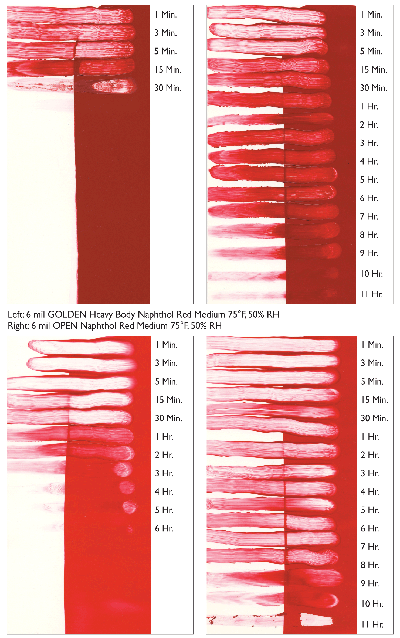 dditionally, some artists like to mist their paintings directly during certain steps in painting, which is perfectly fine, but realize that unwanted droplets on wet areas of a painting will alter the surface unless blended in / brushed over. This can create a great effect if you want it, but can also be potentially frustrating if it’s not desired.
dditionally, some artists like to mist their paintings directly during certain steps in painting, which is perfectly fine, but realize that unwanted droplets on wet areas of a painting will alter the surface unless blended in / brushed over. This can create a great effect if you want it, but can also be potentially frustrating if it’s not desired.
Another easy way to control the humidity in an environment is to purchase a cool air humidifier to actively saturate the studio air with moisture. Simply turn it on prior to painting and off when faster drying is desired. Some may find that this is a more extreme method with some initial associated cost, but it can be really helpful in dryer areas of the country during seasons where houses are naturally dry due to other climate conditions, or for the artist who wants the maximum working time possible.
Temperature can affect the rate of moisture loss in paint, but its effect is less dramatic. It may be common sense that cooler temperatures create an environment that slows paints curing; the reason for this can simply be explained in that the molecules in the air and the molecules in the paint are moving at a slower rate at lower temperatures so there are fewer collisions of air and water to pull moisture away from the surface. That said, there is a limit to how cold one can paint with acrylics and still achieve a stable paint film, so keep rooms above 49F / 9C (at least) and more realistically, in the 60F or above range.
Using this same analogy from above, limiting air movement on the surface of the painting also reduces the molecular interactions. Turning fans away from painting surfaces or paying attention to air conditioning vents in the studio will give the artist more control of their studio. While it may not be for every artist, purchasing a temperature and humidity gauge is a great way to begin understanding the range of climate conditions in ones studio, and it also allows for better control of storage conditions for finished paintings. These can be found for a very reasonable price and many types log information on the maximum and minimum ranges.
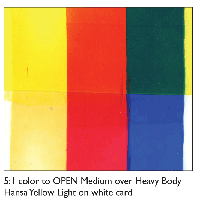
Besides controlling environmental factors, the paint itself can be adjusted to allow for a more relaxed working experience. GOLDEN OPEN Acrylics were created with this need in mind. For the artist who wants to always work with a slower drying product, OPEN allows for an optimized relationship of thickness, pigment load and open time. The OPEN Acrylics product line is great for its ready-made convenience, wide color selection, and slow drying nature right out of the tube. Above are images of OPEN Naphthol Red Medium next to Heavy Body paint modified with various mediums and additives to offer increased working time. Notice how much open time the OPEN Acrylic offers and the difference in color richness and thickness exhibited in the swiped area for the other trials.
These recommendations are for painting on a standard substrate. If working on either a very sealed nonabsorbent surface such as acrylic sheeting, or a very absorbent surface such as watercolor paper, the above guidelines may not apply. Also, when talking about humectants it should be noted that not all are created equal. Some artists have used compounds like glycerin or honey in their paints. This is a bad idea, as neither is volatile and a final non-drying substance similar to fly paper will be created.
Acrylic Glazing Liquid or OPEN Medium are great choices for an “add as much as you want” system because their binder content is carefully controlled to offer significant working time while drying to an acceptable film if used as is, direct from the container. The same binder in these products that allows for a full proof working experience will also increase the transparency of paints; making these mediums useful in creating both slower curing paint as well as slow drying transparent glazes.
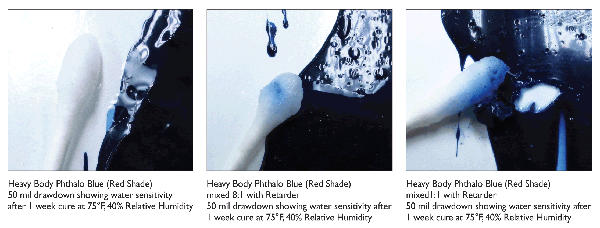
Depending on how an artist maintains their palette or what they are trying to achieve utilizing a specific technique, a thin glaze may not be desirable. To maintain a thicker consistency of paint, but gain slower drying qualities, Silkscreen Medium and OPEN Gel are viable options as they are formulated to have a viscosity similar to Soft Gel (Gloss). These products, much like OPEN Medium and Acrylic Glazing Liquid, can be added at any ratio to paint mixtures without causing issues with drying as long as they are applied moderately thin. This allows for retention of some bristle marks and resistance to sagging on vertical applications. Very thick films may show excessive shrinking upon curing and prolong sensitivity to water or color lifting when over painting. Because of this, it is recommended to keep applications using large amounts of either Silkscreen Medium or OPEN Gel to less than 60 mil, or about the thickness of a penny.
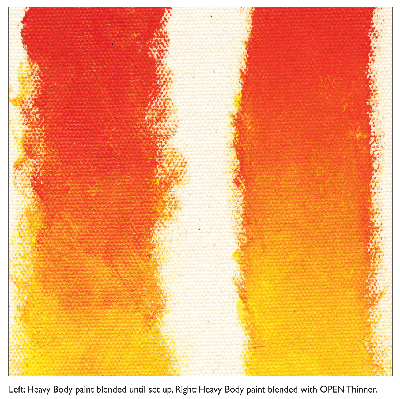
OPEN Thinner was designed originally to replenish the volatile components of OPEN Acrylics. In essence, to keep the OPEN Acrylics hydrated as they sat on the palette. However, this product is also a very useful tool for reducing brush drag. Often regardless of the system of paint you are using, whether it is a slow drying product or conventional acrylic, when blending a passage one may find that there is a certain point in which the curing acrylic wants to ball up versus flow. In these initial stages of coalescence, adding a replenishing dip of OPEN Thinner to ones brush really relaxes the paint back to a workable consistency while providing surface slip for the brush to glide on. The balance of humectant, amine, and water in the OPEN Thinner readily go into the surface layer without overly thinning or pulling off the area you are working on.
H opefully these recommendations offer a better understanding of the mechanisms of drying as well as some possibilities for controlling certain attributes of paint to better serve ones needs. It is recommended to experiment with some or all of the suggestions made in this article to gain personal insight and develop new techniques, and of course, if you have any specific project needs or questions, the GOLDEN Technical Support Services team is always happy to assist. You can reach them by email at [email protected] or you can call toll-free 800-959-6543 or direct at 607-847-6154.
opefully these recommendations offer a better understanding of the mechanisms of drying as well as some possibilities for controlling certain attributes of paint to better serve ones needs. It is recommended to experiment with some or all of the suggestions made in this article to gain personal insight and develop new techniques, and of course, if you have any specific project needs or questions, the GOLDEN Technical Support Services team is always happy to assist. You can reach them by email at [email protected] or you can call toll-free 800-959-6543 or direct at 607-847-6154.
About Ulysses Jackson
View all posts by Ulysses Jackson -->Subscribe
Subscribe to the newsletter today!
No related Post

Please advise as to the ratio of acrylic paint to retarder. Thank you. Susan.
Hello Susan, Typically we suggest starting with 15% and increasing as needed up to 25%. In thin films one can add more then this but it will increase the risk of color lift in subsequent applications. Should you have a specific goal in mind or desire more information please feel free to contact us at [email protected]
Hi! This article was very helpful to me when I was getting started with acrylic a few years ago. Now that I’ve been doing acrylic for a while, I wonder if dew point (which I guess considers both humidity and pressure?) has been considered as a factor more so than just humidity alone. I’m sitting here now waiting over an hour for my layer of gloss medium to dry and watching a tropical storm raining down out the window. I live in a high-humidity area, but the dry time of my paint seems to vary between two days of similar humidity. I haven’t been carefully monitoring it until now, but I think it’s very possible I’ve seen wildly varying results depending on dew point. I understand people can add a humidifier to their studio but can’t alter pressure, so it might seem irrelevant.
Have y’all already looked into this? If not, I might start tracking it and dry time and do my own experiment.
Hello Sarah, We are thrilled that the article was useful to you! We have not factored in atmospheric pressure into our studies regarding dry time (we do when studying permeability) but, as pressure dramatically effects boiling point and vapor pressure it would make sense that high pressure fronts would slow the cure rates of coatings. Unfortunately, studio pressure is a factor that is much harder for an artist to control… If you start to track barometric pressure, humidity, and dry times please keep us posted.
Great article. Thank you.
My background is oils, and about a year ago I swithched to the heavy acrylic line. I miss the pleasures of working with oils. Is there an optimal mixture of OPEN gloss medium (or some other product) for extending drying time (until all my paints are OPEN)?
Thank you Jerry.
There’s no real optimal ratio, as you can adjust the percentages as you need. Higher amounts of OPEN for later stages and details, less OPEN when blocking in sections or are trying to move quickly at certain passages. However, this more recent article in Just Paint may help: https://justpaint.org/open-mixed-with-standard-acrylics-working-time-control/
Hi I have Mondo llama acrylic paint and My temperature in my house is either 69 or 71 is that ok to paint in
Hello Sophie, Thank you for your question. The temperature you stated should be fine to use acrylic paints indoors. We tried to look for technical information on this paint an were unable to find any. If you reach out to Mondo Llama you could ask what the Minimum Film Formation Temperature is for their product. They would be able to give you a more specific number for their paints.
Hope this helps and let us know if you have more questions!
Best regards,
Scott
Is it ok to use a heat gun or hair dryer on open acrylics?
Hello,
Heat Guns at very low settings might be o.k. but avoid temperatures above 100 degrees as high temperatures can begin to break down the acrylic polymers. This is similar to working with a hair drier. If you are finding that the paints dry slower than you need, especially when working with base layers, consider adding a faster drying medium, such as Glazing Liquid or Fluid Matte Medium. These products reduce reapplication times. Here’s another article that I wrote about using mediums to control working time: https://justpaint.org/open-mixed-with-standard-acrylics-working-time-control/ – Mike Townsend